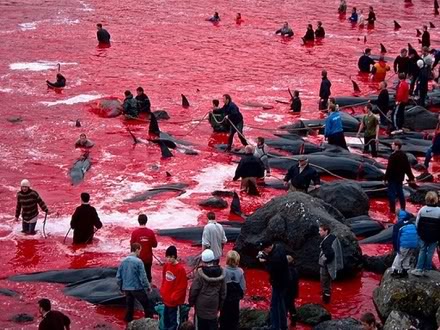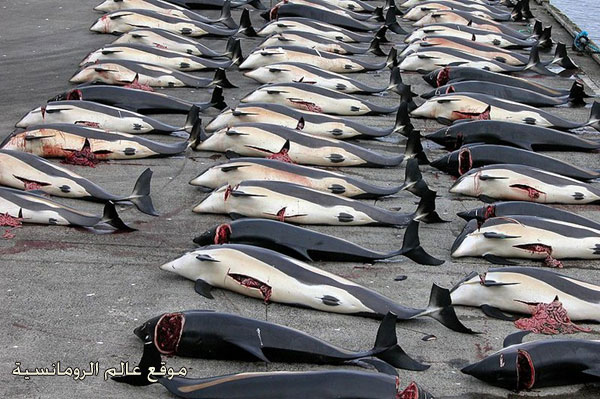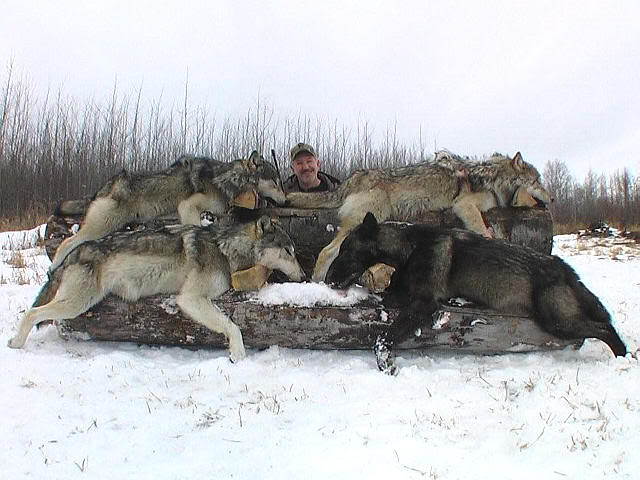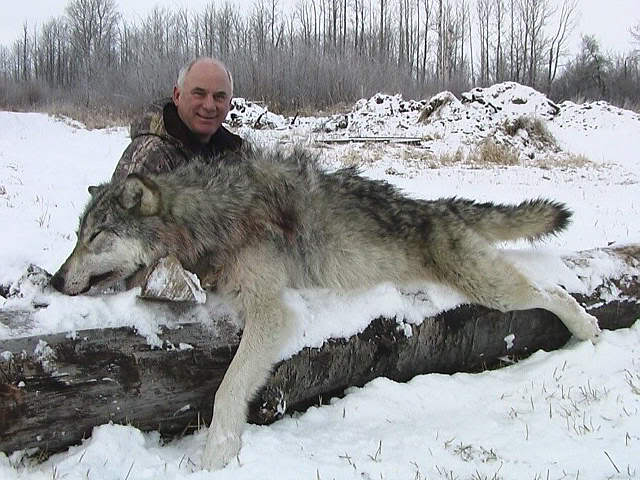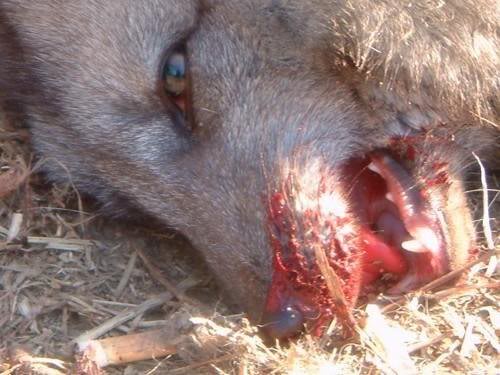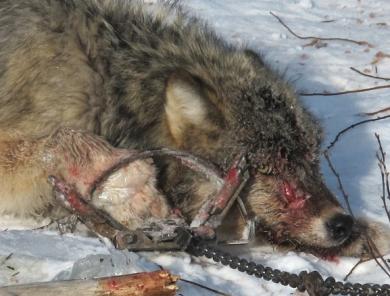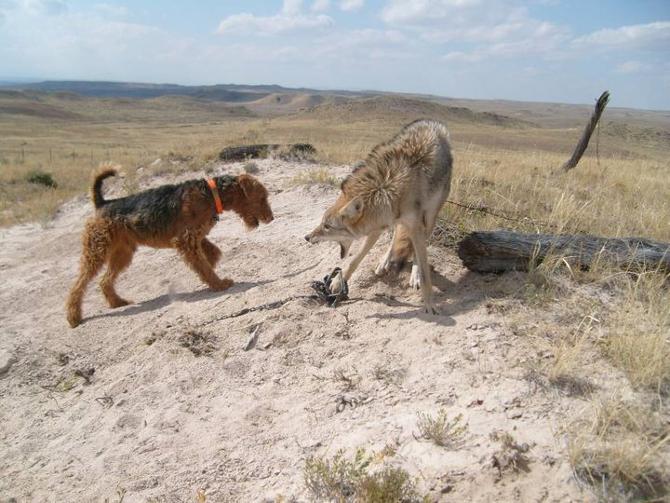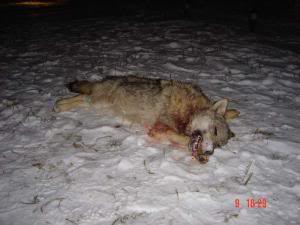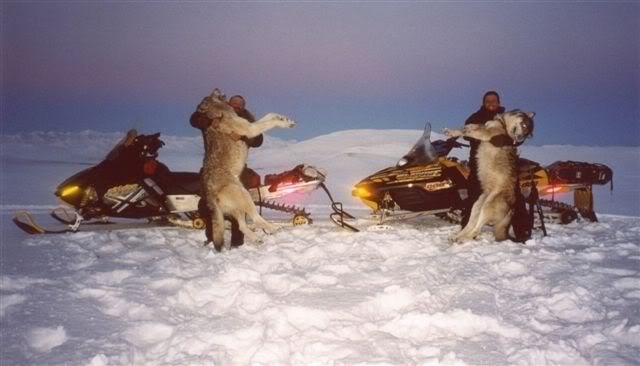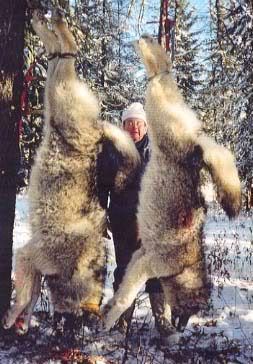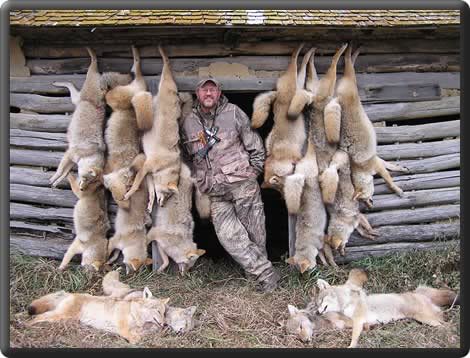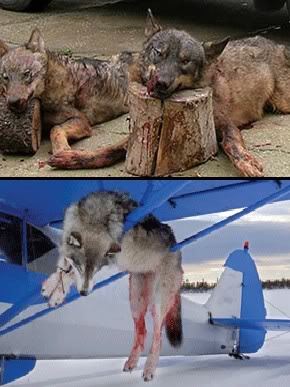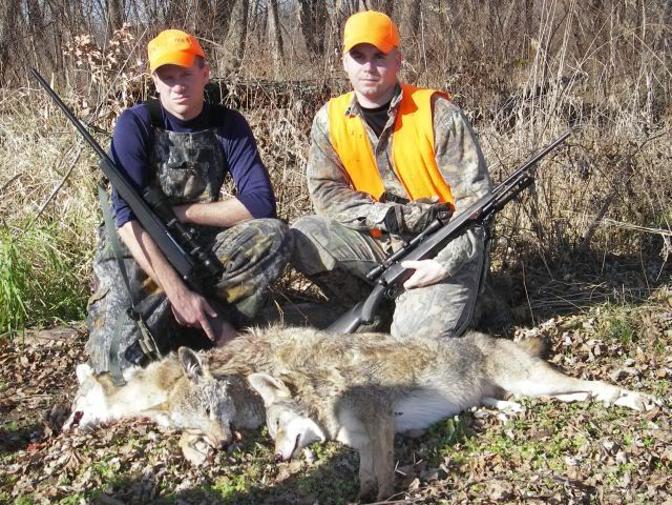Translate This Page
Although it was a crucial part of humans’ survival 100,000 years ago, hunting is now nothing more than a violent form of recreation that the vast majority of hunters do not need for subsistence. Hunting has contributed to the extinction of animal species all over the world, including the Tasmanian tiger and the great auk.
Less than 5 percent of the U.S. population hunts, yet hunting is permitted in many wildlife refuges, national forests, and state parks and on other public lands. Almost 40 percent of hunters slaughter and maim millions of animals on public land every year, and by some estimates, poachers kill just as many animals illegally.
Pain and Suffering
Many animals suffer prolonged, painful deaths when they are injured but not killed by hunters. A member of the Maine Bowhunters Alliance estimates that 50 percent of animals who are shot with crossbows are wounded but not killed.A study of 80 radio-collared white-tailed deer found that of the 22 deer who had been shot with “traditional archery equipment,” 11 were wounded but not recovered by hunters. Twenty percent of foxes who have been wounded by hunters are shot again; 10 percent manage to escape, but “starvation is a likely fate” for them, according to one veterinarian. A South Dakota Department of Game, Fish, and Parks biologist estimates that more than 3 million wounded ducks go “unretrieved” every year. A British study of deer hunting found that 11 percent of deer who’d been killed by hunters died only after being shot two or more times and that some wounded deer suffered for more than 15 minutes before dying.
Hunting disrupts migration and hibernation patterns and destroys families. For animals like wolves, who mate for life and live in close-knit family units, hunting can devastate entire communities. The stress that hunted animals suffer—caused by fear and the inescapable loud noises and other commotion that hunters create—also severely compromises their normal eating habits, making it hard for them to store the fat and energy that they need in order to survive the winter.
Blood-Thirsty and Profit-Driven
To attract more hunters (and their money), federal and state agencies implement programs—often called “wildlife management” or “conservation” programs—that are designed to boost the numbers of “game” species. These programs help to ensure that there are plenty of animals for hunters to kill and, consequently, plenty of revenue from the sale of hunting licenses.
Duck hunters in Louisiana persuaded the state wildlife agency to direct $100,000 a year toward “reduced predator impact,” which involved trapping foxes and raccoons so that more duck eggs would hatch, giving hunters more birds to kill. The Ohio Division of Wildlife teamed up with a hunter-organized society to push for clear-cutting (i.e., decimating large tracts of trees) in Wayne National Forest in order to “produce habitat needed by ruffed grouse.”
In Alaska, the Department of Fish and Game is trying to increase the number of moose for hunters by “controlling” the wolf and bear populations. Grizzlies and black bears have been moved hundreds of miles away from their homes; two were shot by hunters within two weeks of their relocation, and others have simply returned to their homes. Wolves have been slaughtered in order to “let the moose population rebound and provide a higher harvest for local hunters.” In the early 1990s, a program designed to reduce the wolf population backfired when snares failed to kill victims quickly, and photos of suffering wolves were viewed by an outraged public.
Nature Takes Care of Its Own
The delicate balance of ecosystems ensures their own survival—if they are left unaltered. Natural predators help maintain this balance by killing only the sickest and weakest individuals. Hunters, however, kill any animal whose head they would like to hang over the fireplace—including large, healthy animals who are needed to keep the population strong. Elephant poaching is believed to have increased the number of tuskless animals in Africa, and in Canada, hunting has caused bighorn sheep’s horn size to fall by 25 percent in the last 40 years; Nature magazine reports that “the effect on the populations’ genetics is probably deeper.”
Even when unusual natural occurrences cause overpopulation, natural processes work to stabilize the group. Starvation and disease can be tragic, but they are nature’s ways of ensuring that healthy, strong animals survive and maintain the strength level of the rest of their herd or group. Shooting an animal because he or she might starve or become sick is arbitrary and destructive.
Not only does “sport” hunting jeopardize nature’s balance, it also exacerbates other problems. For example, the transfer of captive-bred deer and elk between states for the purpose of hunting is believed to have contributed to the epidemic spread of chronic wasting disease (CWD). As a result, the U.S. Department of Agriculture (USDA) has given state wildlife agencies millions of dollars to “manage” deer and elk populations. The fatal neurological illness that affects these animals has been likened to mad cow disease, and while the USDA and the Centers for Disease Control and Prevention claim that CWD has no relationship to any similar diseases that affect humans or farmed animals, the slaughter of deer and elk continues.
Another problem with hunting involves the introduction of exotic “game” animals who, if they’re able to escape and thrive, pose a threat to native wildlife and established ecosystems.
Canned Cruelty
Most hunting occurs on private land, where laws that protect wildlife are often inapplicable or difficult to enforce. On private lands that are set up as for-profit hunting reserves or game ranches, hunters can pay to kill native and exotic species in “canned hunts.” These animals may be native to the area, raised elsewhere and brought in, or purchased from individuals who are trafficking in unwanted or surplus animals from zoos and circuses. They are hunted and killed for the sole purpose of providing hunters with a “trophy.”
Canned hunts are becoming big business—there are an estimated 1,000 game preserves in the U.S. Ted Turner, the country’s largest private landowner, allows hunters to pay thousands of dollars to kill bison, deer, African antelopes, and turkeys on his 2 million acres.
Animals on canned-hunting ranches are often accustomed to humans and are usually unable to escape from the enclosures that they are confined to, which range in size from just a few yards to thousands of acres. Most of these ranches operate on a “no kill, no pay” policy, so it is in owners’ best interests to ensure that clients get what they came for. Owners do this by offering guides who are familiar with animals’ locations and habits, permitting the use of dogs, and supplying “feeding stations” that lure unsuspecting animals to food while hunters lie in wait.
Many states, including Arizona, Montana, Utah, and Wyoming have limited or banned canned hunts, but there are no federal laws regulating the practice at this time.
Other Victims
Hunting accidents destroy property and injure or kill horses, cows, dogs, cats, hikers, and other hunters. According to the International Hunter Education Association, there are dozens of deaths and hundreds of injuries attributed to hunting every year—and that number only includes incidents involving humans. It is an ongoing problem, and one warden explained that “hunters seem unfamiliar with their firearms and do not have enough respect for the damage they can do.”
The bears, cougars, deer, foxes, and other animals who are chased, trapped, and even killed by dogs during (sometimes illegal) hunts aren’t the only ones to suffer from this variant of the “sport.” Dogs used for hunting are often kept chained or penned and are denied routine veterinary care like vaccines and heartworm medication. Some are lost during hunts and never found while others are turned loose at the end of hunting season to fend for themselves and die of starvation or get struck by a vehicle
|
|
Some seals are killed with a blow to the head using a wooden club or hakapik. The sealers stun as many baby seals as they can before going back to kill them. Some seals try to get away, but they are clumsy on the ice, heaving their fat little bodies with an uncoordinated flipper shuffle. Other seals are shot from a distance and then dragged from the ice onto boats using steel hooks.
Two recent independent veterinary reports on the Canadian seal hunt, as well as IFAW video footage, have documented unacceptable levels of cruelty to baby seals. This hunt is a highly competitive activity, carried out over an extensive area, and under very unpredictable conditions. Haste is the rule, as hunters rush to immobilize as many baby seals as possible in the short time available to them.
Seals are routinely clubbed or shot and left to suffer on the ice, before being clubbed again some time thereafter. Some seals are still skinned before being rendered fully unconscious and few sealers are observed checking for a blinking reflex to confirm brain death prior to skinning an animal. As one of the veterinary reports concluded: "Canada's commercial seal hunt results in considerable and unacceptable suffering.”
The Canadian government often misleads the public by comparing the commercial seal hunt to the killing of farm animals in the food industry. Unlike abattoirs, the seal hunt is an unpredictable, unmanageable hunt for wild animals which takes place under hurried conditions. It is precisely these conditions that have led some experts to conclude that this hunt can never satisfy the requirements of a humane hunt.
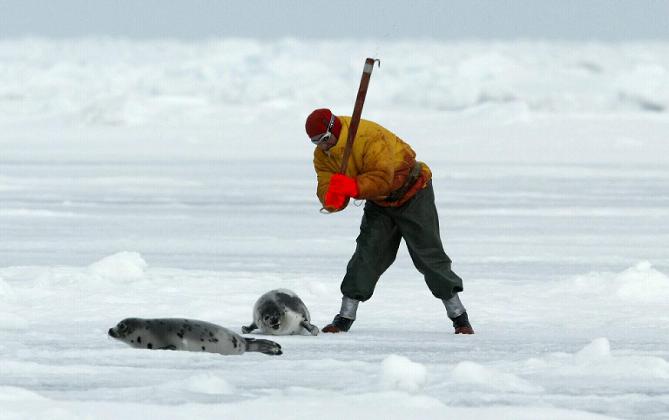
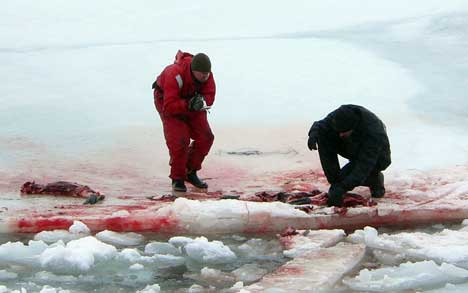
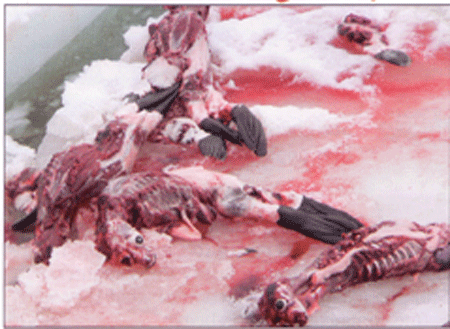
The Japanese invented the concept of ‘scientific’ whaling in 1987 as a way around the moratorium on commercial whaling . Their research is not really research. It is an excuse for supplying whale meat on the Japanese market. The research consists, among other things, of analysis of the contents of the digestive tract. The data on what the animals eat is then used to argue that whales eat too much commercially important fish, and that the populations should be culled to save the fish, and that the Japanese selectively release data on certain species and ignore data on others.
Norway resumed whaling in 1993 “as an attempt by the political party in power at the time to gain popularity in northern Norway,. In order to justify its hunt, Norwegian scientists calculated a population estimate, which was later found to be much higher than the data supported.
And Iceland increased its whaling dramatically in recent years. In 2010 alone, Icelandic whalers killed hundreds of whales,including endangered fin whales—and shipped more than 750 tons of whale meat and products to Japan, whose market is already glutted with whale meat from its own ‘scientific research whaling’ program, reports the non-profit Natural Resources Defense Council (NRDC).
Several green groups including NRDC recently petitioned the Obama administration to take action against Iceland under the Pelly Amendment to the Fisherman’s Protective Act. “The Amendment allows the President to impose trade sanctions against a country that is ‘diminishing the effectiveness’ of a conservation agreement—in Iceland’s case the whaling moratorium and another international treaty that prohibits trade in endangered species,” The petition names several Iceland firms—including major seafood companies with ties to Iceland’s whaling industry—as potential targets for trade sanctions.
Greenpeace has been pressuring Japan to not only end its own whaling but also its support of whaling by other nations not abiding by the IWC moratorium. “We are working around the world to increase the pressure put on Japan by conservation-minded governments at the IWC to close the political loopholes that allow the reckless hunt to continue,” says Greenpeace, “and to highlight the vote-buying that keep these loopholes in existence.”
